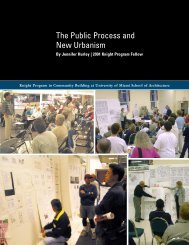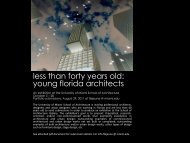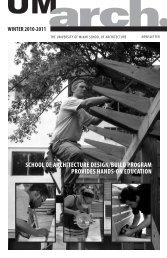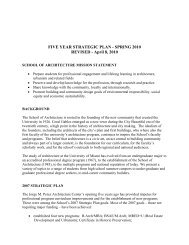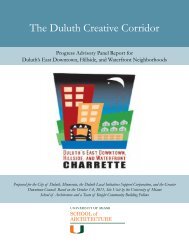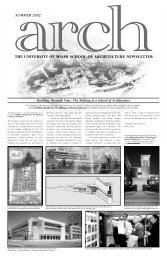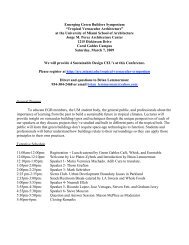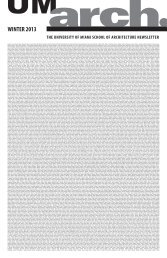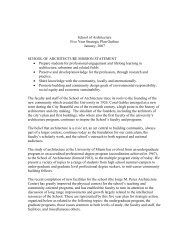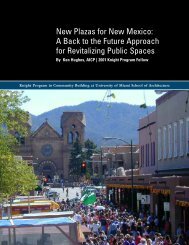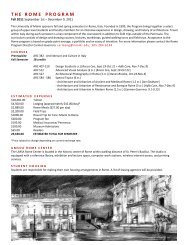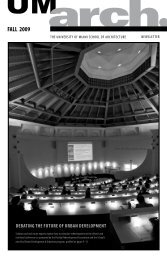Resilience - University of Miami School of Architecture
Resilience - University of Miami School of Architecture
Resilience - University of Miami School of Architecture
Create successful ePaper yourself
Turn your PDF publications into a flip-book with our unique Google optimized e-Paper software.
ethical practice<br />
1.<br />
<strong>Resilience</strong><br />
Tropical Coastal Development<br />
and Ecosystem Health<br />
While architects have contributed in many ways to the richness <strong>of</strong> contemporary<br />
culture, we have also been complicit in the transformaon <strong>of</strong> living<br />
landscapes into ecologically and socially depauperate environments, nourishing<br />
neither human nor non-human life. The AIA code <strong>of</strong> ethics specifically<br />
states that architects have an obligaon to pracce in an ethically and environmentally<br />
responsible manner. (AIA Code <strong>of</strong> Ethics, Canon VI) In his speeches<br />
to the design community, the architect Bill McDonough defines negligence as<br />
proceeding with something we know to be harmful. To this end, we as a pr<strong>of</strong>ession<br />
have been negligent in our obligaon to design for a physically, socially,<br />
and ecologically sound future.<br />
Nowhere is this more evident than in resort cies like <strong>Miami</strong>, where the natural<br />
resources which spurred development have been so quickly and dramacally<br />
altered. There is no way back. However, this thesis proposes a way forward<br />
which allows for the dynamic evoluon <strong>of</strong> both human and natural habit<br />
mediated by a core structure which is both stable and resilient.<br />
4. Miam Art Museum landscape proposal, author<br />
3. Shanghai new town concept, author<br />
urbanism and “nature”<br />
Postmodern ecological theorists have wrien extensively about the arficiality<br />
<strong>of</strong> our concept <strong>of</strong> “Nature,” meaning everything which exists outside the<br />
human sphere. In The Social Creaon <strong>of</strong> Nature, Neil Evernden explains how<br />
this construct is so deeply embedded in our culture that it is difficult to see.<br />
Western religions are based on the assumpon that humans exist outside or<br />
above the rest <strong>of</strong> nature. Yet the system-oriented foundaon <strong>of</strong> modern Ecology<br />
is increasingly influencing the way we look at humans’ place in the world.<br />
Ecologists are increasingly recognizing the need to accommodate human settlements<br />
into conservaon planning, while architects and planners are giving<br />
increasing priority to ecological funcons as criteria for design.<br />
Coastal cies like <strong>Miami</strong> present an especially important challenge. The coastal<br />
zone represents the margin between landscape and seascape, and as a linear<br />
element represents a very small percentage <strong>of</strong> terrestrial or marine habitat.<br />
Through physical form, chemical characteriscs, and species interacons,<br />
coastal zones are among the most crical and biologically producve places on<br />
earth. They are arguably the most threatened.<br />
3




